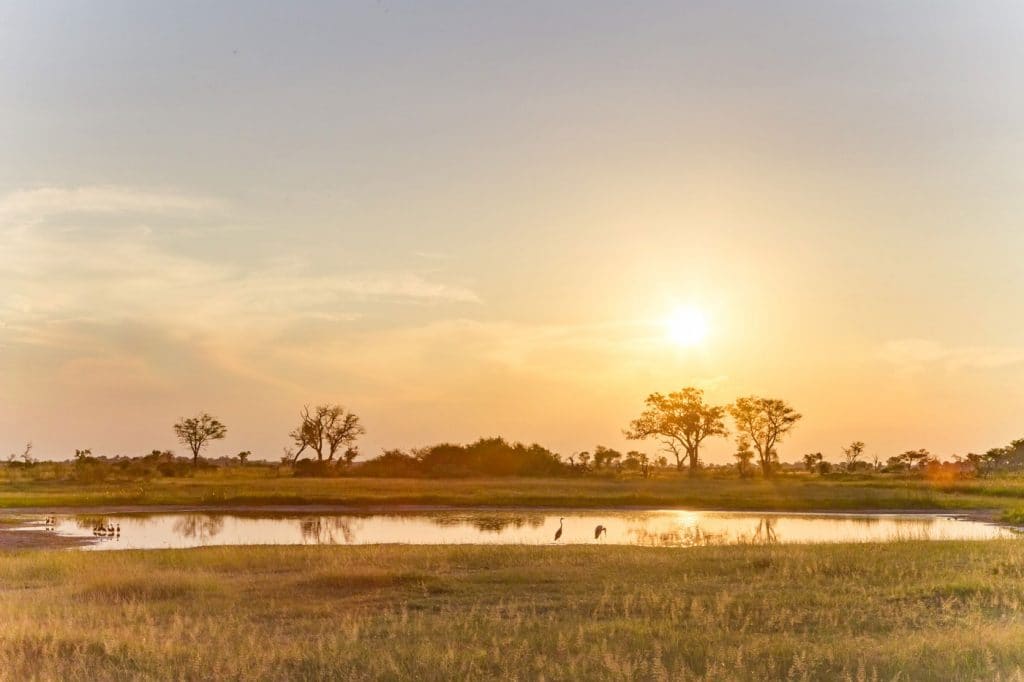Visiting Moremi in the rainy season may seem a bit of a gamble. There’s always the chance of a serious downpour and the roads can be a mess. But once there you’ll find a game-rich, green paradise, fully renewed after the long, dry winter. By Chris Davies
If you’ve been to Moremi in the wet season before you’ll have to forgive my enthusiasm – I imagine you’re already a fan. For myself, a trip in February this year was the first time I’d visited in summer. I’ve always loved Moremi in winter, but I now think the rainy season is better, and here’s why.

1. The lush fertility of it all
Although the Okavango Delta floods in winter and the waterways themselves are green, away from the channels the winter bush is dry and withered and the atmosphere hazy with dust. The contrast with summer couldn’t be more stark, with endless fresh grass and crisp skies. The bush feels so much healthier in the abundance of summer and the animals seem much more relaxed.

2. Healthy adults and playful juveniles
This healthy abundance is especially obvious in the number of fat grazers and their kids. I’ve never seen such large herds of buffalo, and every group of antelope had calves. Hippos were content to munch grass out of the water under the protection of midday clouds. And with so much fresh grass on the open floodplains it wasn’t at all difficult to spot animals.

3. Predators!
Big cats in particular are supposed to be easier to spot when the bush is dry and thin. That may be true as a general rule, but then Moremi may be something of an anomaly. As well as plenty of spotted hyena, we saw lions on three occasions – two lone males, a separate young pride and a solo female on the prowl. Add three juvenile leopards (their mum didn’t appear) and it’s easily the most predators I’ve seen on one trip.
Also read: Taking the Tracks4Africa Navigation App off-road in Botswana

4. Fantastic birdlife
Summer is well known to be best season for birds – some 450 species have been recorded in the Delta. Although I’m not a huge birder and can’t point to any lifers, the numbers and variety were extraordinary. Third Bridge campsite was particularly memorable, where a darting, fuchsia swarm of southern carmine bee-eaters greeted us on arrival.

5. Dramatic skies
The rain-washed air and dramatic clouds make Moremi particularly photogenic in summer. Vivid greens contrast with pastel-tinted skies and a big storm can be especially striking. With all the juveniles around it’s also a fine time for wildlife photography and with the animals so relaxed it’s easy to get up close without needing a top-range telephoto lens.

6. Spectacular storms
Photographing bush thunderstorms is invariably rewarding, but you don’t need a camera to appreciate them. It’s fascinating to observe the change in animal behaviour as lightning flashes and the rain buckets down. Camping in a storm can obviously have its drawbacks and you’ll need a decent awning and/or sturdy gazebo. Or take the opportunity for a quick outdoor shower. There are few things more refreshing in the world.
Also read: Okavango Delta through the eyes of an award-winning photographer

7. Muddy trails
Such heavy downpours generally mean mud and it’s a good idea to travel with two vehicles. If you don’t like it muddy then this isn’t your season, but don’t let a bit of mud put you off. Moremi’s roads have always been pretty rough and I didn’t find them any worse in summer. Winter’s bumpy ditches become muddy pools in summer but were no harder to cross when filled with water. It was good to have two vehicles just for peace of mind, but the mud was more fun than intimidating.
There is one downside I will concede: water-based excursions in summer. Summer means low floodwaters across the Delta and any boating activities are hit and miss. Xakanaxa and the Mboma Boat Station were still running trips, but only by motorboat, out to the deepest channels. If it’s a mokoro safari you’re after, then June to October are still best, and it’s also the best time to visit Gcudikwa Island.
Travel Botswana Informed
The Botswana Self-Drive Guidebook Edition 2 is the quintessential guidebook for overlanders who love to go off the beaten track. Filled with detailed maps, travel advice and useful contact details, it’s got everything you need to plan the perfect road trip. Best of all, the traveller descriptions provide context and recommendations, helping you to make the most of your journey.
Get your copy


